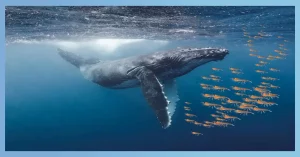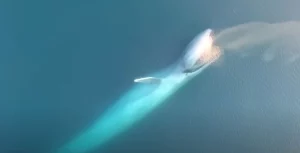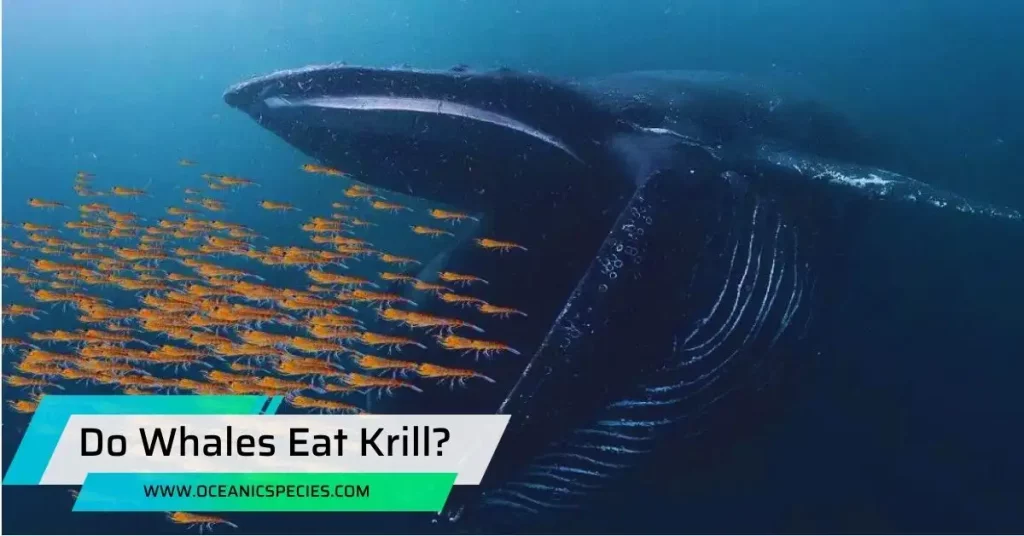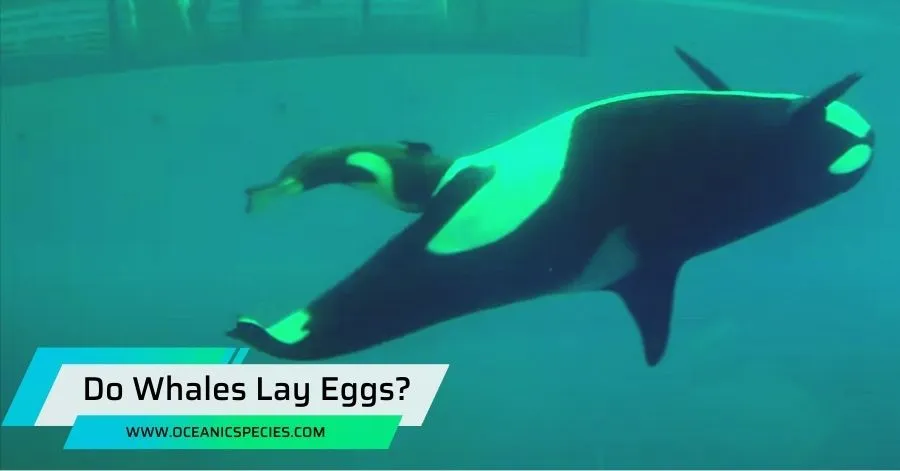Whales eat a variety of species from the entire food chain, including zooplankton, krill, and other large mammals. Some species feed on swarms of zooplankton, while others feed on schooling fish.
The sperm whale, for example, feeds on squid. Blue whales, the largest animals on Earth, consume up to four tons of krill a day, which makes up the majority of their diet. Other baleen whales, like humpback whales, also feed on krill and are considered filter feeders.
These whales play a crucial role in maintaining the balance of marine ecosystems by regulating the populations of their prey species. Understanding the feeding habits of whales is important for conservation efforts and ensuring the sustainability of these magnificent creatures.
Understanding The Whale’S Diet
Whales have a diverse diet, ranging from small zooplankton to large mammals. While some whales feed on swarms of krill, others prefer schooling fish or squid. Regardless, the incredible blue whale can consume up to four tons of krill each day to sustain its massive size.
Importance Of Studying Whale Feeding Habits:
Studying the feeding habits of whales is crucial for several reasons. Here are a few key points to consider:
- Understanding the food sources: By studying what whales eat, scientists gain insight into the availability and abundance of different marine species. This information helps researchers monitor changes in ecosystems and identify potential disruptions in the food chain.
- Conservation efforts: Whales play a vital role in maintaining the balance of the marine ecosystem. By studying their feeding habits, scientists can assess the overall health of whale populations and implement conservation measures to protect these majestic creatures.
- Impact on other species: Whales are often referred to as “keystone species” because their feeding habits can have a significant impact on other marine organisms. For example, if whales were to consume a specific species of fish or krill, it could have a cascading effect on the entire food web.
A Diverse Diet Of Marine Species:
Whales have a remarkably diverse diet, depending on their species and habitat. Here are some noteworthy points:
- Filter feeders: Baleen whales, such as the blue whale and humpback whale, are filter feeders. They have baleen plates in their mouths that act as filters, allowing them to consume small prey like krill and other planktonic organisms. These whales take large gulps of water and filter out the food using their baleen.
- Toothed whales: Toothed whales, such as killer whales and sperm whales, have a more varied diet. They are skilled hunters and consume a range of marine species, including fish, squid, and sometimes even other marine mammals. These whales have sharp teeth to catch and consume their prey.
- Krill as a food source: While not all whales eat krill, many species rely on krill as a significant part of their diet. Krill are shrimp-like crustaceans that form large swarms in the oceans. They are a crucial food source for various marine animals, including penguins, seals, and certain whale species.
Krill: A Staple In Whale Diets
Whales have a diverse diet, with some species feeding on krill, which are small shrimp-like organisms. Krill is a staple in the diets of baleen whales, such as blue whales, providing them with the necessary sustenance to fuel their massive bodies.

In this section, we’ll explore the implications of krill for whale survival and the abundance of krill in the ocean.
Implication Of Krill For Whale Survival:
- Krill provides essential nutrients: Whales rely on krill as a primary food source due to its high nutritional value. Krill is rich in proteins, oils, and minerals that are vital for the growth and maintenance of whale populations.
- Energy-packed meals: Krill contains high concentrations of energy, allowing whales to fulfill their substantial energy requirements. These small creatures are a convenient and energy-dense food source for whales, enabling them to sustain their massive size.
- Baleen whales’ feeding technique: Baleen whales, such as blue whales and humpback whales, have evolved unique baleen plates in their mouths, which act as filters. These whales engulf large quantities of water containing krill, filtering it through their baleen to trap and consume the krill. This feeding technique allows them to efficiently extract the krill from the water.
- Cooperative hunting: Certain whale species, like humpback whales, exhibit cooperative hunting behavior when pursuing krill. They work together to corral krill into tight groups, making it easier for them to feed on large krill patches. This cooperation maximizes their feeding efficiency and ensures they can obtain enough food to sustain themselves.
Abundance Of Krill In The Ocean:
- The foundation of marine ecosystems: Krill forms the foundation of many marine ecosystems, particularly in the polar regions. It serves as a crucial link in the food chain, converting tiny plant-based organisms into a readily available food source for numerous marine species, including whales.
- Massive swarms: Krill exists in immense swarms that can span several square kilometers. These swarms can contain millions of individual krill, creating an abundant and concentrated food source for whales. The vast numbers of krill ensure that whales have access to sufficient quantities of food to survive and thrive.
- Seasonal variations: Krill populations experience seasonal fluctuations, influenced by factors such as water temperature and ice coverage. During the warmer months, krill populations tend to thrive, providing whales with ample feeding opportunities. However, in colder seasons, krill populations may decline, forcing whales to adapt their feeding patterns or seek alternative food sources.
Whale Species And Krill Consumption
Whales have a diverse diet, consuming various species from zooplankton to larger mammals. Some whales specifically feed on krill, while others prey on schooling fish. Sperm whales, on the other hand, primarily eat squid. Blue whales, the largest creatures on earth, can consume up to four tons of krill each day to sustain their massive bodies.
Blue Whales And Their Voracious Appetite For Krill:
Blue whales are the largest animals on Earth and are known for their impressive size and appetite. These majestic creatures can consume up to 4 tons of krill in a single day.
The diet of a blue whale primarily consists of krill, which are small shrimp-like crustaceans found in the ocean. They feed by engulfing massive amounts of water and then filter it through their baleen plates to trap the krill, which they then swallow.
Blue whales have been observed performing lunge feeding, where they accelerate towards a dense patch of krill and open their mouth wide, engulfing both the krill and a large volume of water.
Humpback Whales And Their Reliance On Krill As A Food Source:
Humpback whales also have a strong affinity for krill and heavily rely on it as a food source. These whales are known for their acrobatic behaviors, such as breaching and slapping their tails on the water’s surface. Humpback whales have baleen plates in their mouths, which they use to filter out their prey, including krill.
They are innovative feeders and have been observed using a technique called bubble-net feeding, where they blow a circle of bubbles around a school of fish or krill, creating a barrier that forces the prey to concentrate in a tight ball. This makes it easier for the whales to engulf and consume their meal. Humpback whales can consume several thousand pounds of krill in a day during the feeding season.
Beyond Krill: Other Prey Of Whales
Whales have a diverse appetite, consuming a variety of species from zooplankton to large mammals. Some species, like the blue whale, rely heavily on krill as their main food source, consuming up to four tons a day to sustain their massive bodies.
However, other whales also feed on schooling fish and squid.
Baleen whales and their consumption of other zooplankton:
- Baleen whales, such as the blue whale and the humpback whale, have baleen plates instead of teeth. These plates act as filters to trap small prey while allowing water to pass through.
- Besides krill, baleen whales also consume other types of zooplankton, such as copepods and small fish.
- Copepods are tiny crustaceans that serve as an essential food source for many marine animals, including baleen whales.
- Some species of baleen whales, like gray whales, also feed on bottom-dwelling organisms by filtering sediment-rich water.
Toothed whales and their preference for squid:
- Toothed whales, such as the sperm whale and the killer whale, have teeth that enable them to catch and consume larger prey compared to baleen whales.
- While toothed whales do eat krill and other small fish, their preferred prey is often squid due to its high nutritional value.
- Squid provides toothed whales with essential fatty acids and other nutrients necessary for their survival.
- Toothed whales use echolocation to locate and capture their prey, emitting sound waves that bounce back to help them determine the location, size, and shape of squid.
The Hunting Techniques Of Whales
Whales have diverse hunting techniques and their diet includes a variety of species. While some feed on swarms of zooplankton such as krill, others consume schooling fish or squid. Whales can consume up to four tons of krill per day to fuel their massive bodies.

Whales, as majestic marine creatures, have developed various hunting techniques to capture their primary prey, krill. These techniques enable them to efficiently locate, approach, and consume large quantities of krill. Let’s explore two fascinating hunting techniques used by whales: lunge feeding and echolocation.
Lunge Feeding: How Whales Capture Their Prey
Whales utilize a technique called lunge feeding to engulf vast amounts of krill in a single motion. During lunge feeding, whales accelerate towards their prey, opening their enormous mouths to create a large cavity.
As the whale approaches a dense concentration of krill, it engulfs a massive volume of water and krill into its mouth. To filter out the seawater, whales possess baleen plates that act as a sieve, allowing water to escape while retaining krill.
After filtering the water, the whale swallows the captured krill, ready to repeat the process for its next meal.
Echolocation: How Whales Locate Krill And Other Prey
Echolocation is a vital sensory mechanism that whales use to locate krill and other prey in the vast ocean. Whales emit a series of sound waves or clicks, which travel through the water and bounce back when they encounter an object.
By analyzing the returning echoes, the whale can determine the distance, size, and location of potential prey. This specialized ability allows whales to navigate in dark or murky waters, relying on sound rather than sight.
Once a whale detects a concentration of krill through echolocation, it can adjust its course to pursue its prey effectively.
Conservation And The Impact On Whale Feeding Habits
Blue whales, the largest animals in the world, consume up to four tons of krill daily as a source of fuel. They are one of many whale species that feed on these tiny crustaceans, highlighting the importance of conservation efforts to protect whale feeding habits.
Human Activities And Their Effect On The Availability Of Krill:
- Overfishing: Large-scale fishing operations that target krill directly reduce the available food source for whales. This, in turn, affects the ability of whales to find enough food to survive.
- Climate change: Rising sea temperatures, melting polar ice, and changes in ocean currents impact the distribution and abundance of krill. As a result, whale feeding grounds may become less productive or shift to areas with lower krill populations.
- Pollution: Pollution from industries, oil spills, and plastics can contaminate krill habitats, making it difficult for them to survive and reproduce. Without a thriving krill population, whales may struggle to find enough food.
The Importance Of Protecting Whale Feeding Grounds:
- Ecosystem balance: Whales play a crucial role in maintaining the balance of marine ecosystems. By consuming large quantities of krill, they help control the population of these small organisms and prevent overpopulation.
- Biodiversity: Whales are not only important for their own species but also for the diverse range of marine life that depends on them. Protecting whale feeding grounds ensures the preservation of various organisms that are interconnected in a complex web of life.
- Conservation efforts: Creating marine protected areas and enforcing sustainable fishing practices are essential for safeguarding whale feeding grounds. These measures can help ensure a stable and healthy krill population, benefiting both whales and the overall marine environment.
Frequently Asked Questions
Why Do Whales Eat Krill?
Whales eat krill because it provides them with a high-energy food source.
How Do Humpback Whales Eat Krill?
Humpback whales eat krill by using their baleen plates to filter them out of the water.
Conclusion
While some whales feed on zooplankton and krill, others opt for schooling fish or squid. The blue whale, being the largest animal on the planet, relies heavily on krill for sustenance.
It consumes an astonishing four tons of krill per day, with these two-inch-long organisms making up the majority of its diet. In contrast, humpback whales, as well as other baleen whales, are filter feeders, using baleen plates to strain small prey from the water.
These magnificent marine mammals display remarkable feeding adaptations, allowing them to thrive in their ocean habitats. Whether they’re engulfing krill in massive gulps or filtering out prey with their specialized baleen plates, whales are a testament to the biodiversity and ecological balance of our oceans.
Through research and conservation efforts, we can gain a deeper understanding of how whales eat krill and play our part in preserving their remarkable existence.


